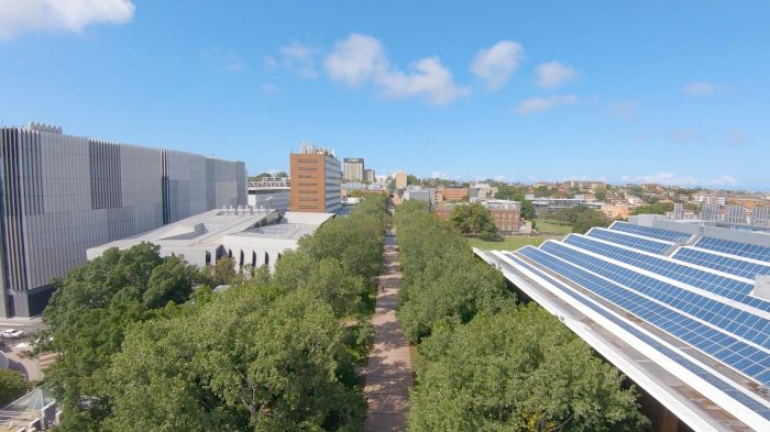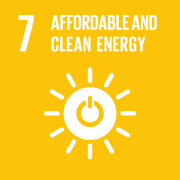Why do we celebrate clean energy?
Did you know, in 2023, fossil fuels made up 82% of the global energy mix, generating 68% of global greenhouse gas emissions1, the leading driver of climate change. On the bright side, Australia leads the world in solar uptake per capita with nearly 40% of electricity in the National Electricity Market coming from renewables in 20232.
Clean energy, including solar, wind, hydropower, geothermal and green hydrogen, produces no greenhouse gas emissions during use and is central to achieving Sustainable Development Goal #7: ensuring affordable, reliable and sustainable energy for all.
International Day of Clean Energy calls us to accelerate the shift to clean energy and create a fairer energy future. Reducing energy consumption and improving efficiency in transport, buildings, lighting and appliances is essential for decreasing global energy use and supporting the transition.
Leading the way in clean energy at UNSW
UNSW consumes energy from the grid and natural gas networks for powering our buildings and campuses. Transitioning away from fossil fuels is a key priority of the UNSW Environmental Sustainability Plan. Here's how the university is accelerating this change:
- Switched to 100% renewable electricity in 2021 thanks a solar Power Purchase Agreement (PPA) with Sunraysia Solar Farm/,
- expanded onsite solar photovoltaic capacity to 1.5 MWp,
- improved energy efficiency by auditing and retro-commissioning Heating, Ventilation, and Air Conditioning (HVAC) systems in energy-intensive buildings,
- accelerating the clean electrification program, starting with Colombo House in August 2024, transitioning it from natural gas to clean electricity. All UNSW colleges and Paddington campus are on track to follow by the end of 2025. By 2030, all campuses will be fully electrified and powered entirely by renewable energy.
Who’s working on solutions right here at UNSW?
In this first sustainability spotlight article, we are showcasing the work of Joshua Geller, Research Assistant and Bachelor student in the School of Photovoltaic & Renewable Energy Engineering.
1. Can you share a quick summary of your project or work in one sentence?
My journey started with UNSW’s SOLA5056 Sustainable Energy in Developing Communities course led by Dr Anna Bruce. The highlight of the course was a field trip to Fiji supported by the New Colombo Plan scholarship, where I joined a team visiting remote island communities to collect data, repair solar systems, and help install a solar freezer.
After this experience, I decided to focus my engineering honours thesis on the Fijian Solar Home System program, which has provided energy to over 13,500 households since 2009. I identified challenges like system degradation, limited maintenance support, and a mismatch between community needs and available energy services. Ultimately, my research provided evidence-based, context-specific recommendations to address these overlooked issues.
2. How does your work contribute to the theme of clean energy?
My research addresses critical gaps in clean energy programs for rural electrification. By identifying operational and maintenance challenges, I aim to inform future programs and ensure their long-term success. Ultimately, I aim to promote energy justice for underserved communities, advancing SDG7.
3. What’s the most exciting or surprising thing about what you do?
The most exciting part has been engaging directly with Fijian communities and seeing the transformative impact of clean energy: lighting homes, enabling education, and powering livelihoods. It’s inspiring but also humbling to witness their resilience despite system challenges.
4. Who’s a researcher or project you’d recommend we keep an eye on in this space?
There are so many exciting and important projects going on at UNSW in this space – but I’d recommend following two UNSW researchers, Dr Paul Munro and Dr Shanil Samarakoon. Their past and current research looks at the importance of solar maintenance, repair and e-waste in shaping energy justice in the Global South.
We all have a role to play, and it starts at UNSW.
- In the lab: explore the LEAF Library for ways to reduce your lab’s energy use. Not part of LEAF yet? Join over 90 teams at UNSW leading sustainable lab practices.
- At work: switch off energy-intensive equipment when not in use, ensuring it is safe to do so.
- On your commute: reduce your transport energy by opting for active travel options. Check out the sustainability map for end-of-trip facilities.
- At home:
- Replace natural gas with electrical appliances,
- switch to a renewable electricity provider or install solar energy.
- Need inspiration?
- Short read: The New Energy Order from Gregory Andrew
- Long read: The Big Switch from Saul Griffith for a deeper dive into clean energy solutions
Happy International Day of Clean Energy!
Stay tuned for our next Sustainability Spotlight on World Wildlife Day.
__________________________________________
[1] United Nations Environment Programme (2024). Emissions Gap Report 2024: No more hot air … please! With a massive gap between rhetoric and reality, countries draft new climate commitments. Nairobi. https://doi.org/10.59117/20.500.11822/46404.
[2] ‘ELECTRIC SHOCK! AUSTRALIA’S LIGHT-BULB MOMENT’ (2025) https://www.climatecouncil.org.au/ [Preprint]. Available at: https://www.climatecouncil.org.au/wp-content/uploads/2025/01/Electric-Shock-Australias-lightbulb-Moment_Climate-Council.pdf (Accessed: 21 January 2025).



